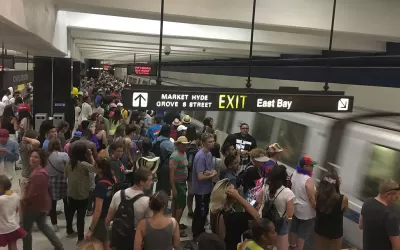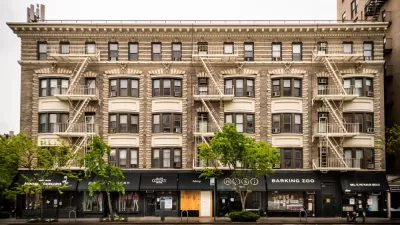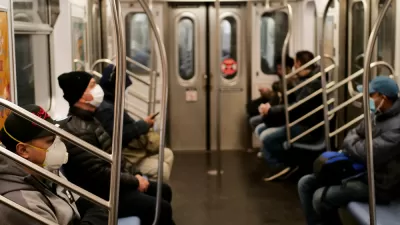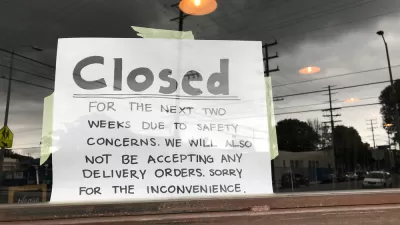Public transit is critical for efficient and equitable transportation, but it is currently under threat due to fears of COVID-19 contagion. Now, more than ever, planners must communicate transit benefits and respond to inaccurate criticisms.

Public transportation plays unique and important roles in an efficient and equitable transportation system. It provides affordable mobility for non-drivers, efficient urban travel, and a catalyst for more compact and multi-modal development. Even people who do not ride transit themselves benefit from having high-quality service in their communities. However, conventional planning tends to undervalue many of these benefits, and public transit often faces unjustified criticism by people who claim that it is an inefficient and outdated. This is particularly true now, during the COVID-19 pandemic, when ridership has plummeted and many people exaggerate its contagion risk. This column provides guidance for communicating transit benefits and responding to criticisms. It summarizes information from my reports, Evaluating Public Transit Benefits and Costs and Pandemic-Resilient Community Planning.
Understanding Public Transit Benefits
Public transit can provide numerous benefit, including many that are indirect and long-term. Some result from the existence of the service, others from transit use, some from reduced automobile travel, and others from transit’s ability to affect land use development patterns. Below are various categories of these benefits.
Transit Service Improvements
- Improved convenience and comfort for existing users.
- Equity benefits, by providing basic mobility to people who cannot drive.
- Option value (the value of having an option for possible future use).
- Improved operating efficiency (if service speed increases).
- Improved passenger safety and security.
Increased Transit Travel
- Mobility benefits to new users.
- Increased fare revenue.
- Increased public fitness and health (by stimulating more walking or bicycling trips).
- Increased security as more non-criminals ride transit and wait at stops and stations.
Reduced Automobile Travel
- Reduced traffic congestion.
- Road and parking facility cost savings.
- Consumer savings.
- Reduced chauffeuring burdens.
- Increased traffic safety.
- Energy conservation.
- Air and noise pollution reductions.
Transit-Oriented Development (TOD)
- Additional vehicle travel reductions.
- Improved accessibility, particularly for non-drivers.
- Community cohesion (due to more neighborhood walking activity).
- More efficient development (reduced infrastructure costs).
- Farmland and habitat preservation.
Conventional planning tends to overlook many of these benefits. For example, by tradition, conventional transportation project economic evaluation assumes that households will own the same number of vehicles regardless of transit service quality and ridership, and so ignores the household vehicle ownership savings if transit service improvements reduce driving or if transit-oriented development reduces vehicle ownership rates. Similarly, conventional project evaluation ignores parking costs, and therefore the very large savings to business and governments if commuters shift from driving to riding transit, or if TOD residents own fewer vehicles. Social equity benefits, health benefits, reduced chauffeuring burdens, and local economic development benefits also tend to be overlooked or undervalues in conventional transportation planning.
What Benefits are Most Important Now
This pandemic has demonstrated the important role that public transit plays in providing basic mobility, including commuting by essential workers, and errands by non-drivers living in isolated neighborhoods. It also demonstrates the value of living in compact, walkable neighborhoods where commonly-used services are easy to access without a car.
Now and for the foreseeable future many households will be financially strained; they will have less income and more expenses than pre-pandemic. Some will have difficulty making car and vehicle insurance payments, or buying fuel, and will need to choose between vehicle or housing expenses. For them, transit and transit-oriented development can provide essential cost savings.
The pandemic temporarily reduced all types of travel, so traffic congestion, parking problems and vehicle pollution do not seem to be major problems right now. However, they will return as economic activity grows. As a result, I would not highlight them as justifications to support transit in the short run, but would describe them as reasons to support long-term public transit improvements and more transit-oriented development.
When discussing public transit benefits and costs it is useful to put infectious disease risks into perspective. High quality public transit significantly reduces traffic crash and air pollution deaths, and increases public fitness and health. As a result, any incremental health risks are probably offset by these other health benefits, particularly if transit agencies implement pandemic risk reduction best practices, such as those summarized below.
Understanding Contagion Risk
Many people assume that public transit travel is a major cause of infectious disease contagion, but current research suggests that is untrue or greatly exaggerated, as discussed in my previous column, "Lessons from Pandemics: Transportation Risks and Safety Strategies." In fact, various studies (Automobiles Seeded the Massive Coronavirus Epidemic in New York City, It’s Easy, But Wrong, to Blame the Subway for the Coronavirus Pandemic and The Subway is Probably not Why New York is a Disaster Zone) show that within urban regions, COVID-19 infection and death rates are higher in more automobile-dependent suburbs than in transit-oriented neighborhoods. Recent international research also shows low infection rates associated with public transit travel.
What can explain these results? Every community has many people who cannot drive. In urban neighborhoods they rely primarily on walking and bicycling, with occasional transit trips. In sprawled, automobile-dependent areas they rely on rides provided by family and friends, and on taxi and ridehailing trips. These risks are difficult to compare, but there is no reason to expect less risk if 1,000 non-drivers travel as single passengers in 1,000 private cars, or in 500 taxi/ridehail vehicles with a driver and two average passengers, than if they travel on 100 buses with 10 average passengers, or 50 train cars with 20 average passengers. Automobiles have less room and more touch surfaces than most public transit vehicles. The results speak for themselves: public transit seems to have less risks than other types of shared vehicle travel.
Positive Action
The good news is that public transit can provide large and diverse benefits; there is something for everybody. The bad news is that many of these benefits tend to be overlooked, particularly during this pandemic when most people are focusing on contagion risks. Available research indicates that public transit is no more dangerous than other shared-vehicle travel. The challenge for planners is to communicate the important role that public transit plays in creating an efficient and equitable transportation system, ensure that transit travel is as attractive and safe as possible, and to respond to exaggerated fears of transit.
Here are some specific recommendations for supporting public transit:
- Become familiar with the full range of public transit benefits and safety strategies. Assemble fact sheets designed for various audiences including transit users, local businesses, health professionals, affordability advocates, environmentalists, operators and passengers.
- Ensure that passengers have the resources they need to safety use public transit, for example, by providing free or discounted hand sterilizer and face masks.
- Don't focus on public transit alone; give equal consideration to active modes (walking and bicycling), since they are complementary; many people rely on both. For example, improving walking conditions is one of the best ways to encourage public transit travel, since most transit trips include walking links.
- Balance warnings and safety regulations with positive messages about the overall safety and health benefits of public transit travel.
- Celebrate transit operators and responsible passengers as heroes and role models.
This is a good time to propose public transit improvements that reduce delays and crowding, or improve air quality, such as dedicated bus lanes and other bus priority strategies; automated payment systems or fare-free transit; all-door loading; improved ventilation; better passenger waiting conditions; better communications systems; plus improved operator protection.
Public transit faces many challenges and criticisms - which now include exaggerated contagion fears. It is up to planners to ensure that everybody involved - public officials, transportation professionals, transit operators and passengers - has accurate and comprehensive information about the true benefits and risks of transit.
For More Information
Nick Allison, David Lupton and Ian Wallis (2013), Development of a Public Transport Investment Model, Research Report 524, NZ Transport Agency.
James Brasuell (2020),Staying Healthy While Riding Public Transit in the Pandemic, Planetizen.
Christopher E. Ferrell (2015), The Benefits of Transit in the United States: A Review and Analysis of Benefit-Cost Studies, Mineta Transportation Institute.
Frank Gallivan, et al. (2015), Quantifying Transit’s Impact on GHG Emissions and Energy Use—The Land Use Component, Report 176, Transit Cooperative Research Program.
Melissa M. Laube, Lydia Rainville and William M. Lyons (2014), A Multi-Modal Approach to Economic Development in the Metropolitan Area Transportation Planning Process, Volpe National Transportation Systems Center, U.S. Department of Transportation.
Todd Litman (2017), Raise My Taxes, Please! Evaluating Household Savings From High Quality Public Transit Service, Victoria Transport Policy Institute.
Todd Litman (2018), Evaluating Public Transportation Health Benefits, American Public Transportation Association.
Todd Litman (2019), Evaluating Public Transit Criticism, Victoria Transport Policy Institute.
Todd Litman (2019), Evaluating Public Transit Benefits and Costs, Victoria Transport Policy Institute.
Todd Litman (2020), Pandemic-Resilient Community Planning: Practical Ways to Help Communities Prepare for, Respond to, and Recover from Pandemics and Other Economic, Social and Environmental Shocks, Victoria Transport Policy Institute.
NACTO (2018), Making Transit Count: Performance Measures that Move Transit Projects Forward, National Association of City Transportation Officials.
Christopher Porter, et al. (2015), Selected Indirect Benefits of State Investment in Public Transportation, Research Results Digest 393, NCHRP Project 20-65, Task 52, National Cooperative Highway Research Program.
Heather Unger, et al. (2019), Social and Economic Sustainability Performance Measures for Public Transportation, TCRP Research Report 205, Transportation Research Board.
Jarrett Walker (2012), Human Transit: How Clearer Thinking about Public Transit Can Enrich Our Communities and Our Lives, Island Press.
M. Wedderburn (2013), Improving the Cost-Benefit Analysis of Integrated PT, Walking and Cycling, Research Report 537, NZ Transport Agency.

Maui's Vacation Rental Debate Turns Ugly
Verbal attacks, misinformation campaigns and fistfights plague a high-stakes debate to convert thousands of vacation rentals into long-term housing.

Planetizen Federal Action Tracker
A weekly monitor of how Trump’s orders and actions are impacting planners and planning in America.

San Francisco Suspends Traffic Calming Amidst Record Deaths
Citing “a challenging fiscal landscape,” the city will cease the program on the heels of 42 traffic deaths, including 24 pedestrians.

Defunct Pittsburgh Power Plant to Become Residential Tower
A decommissioned steam heat plant will be redeveloped into almost 100 affordable housing units.

Trump Prompts Restructuring of Transportation Research Board in “Unprecedented Overreach”
The TRB has eliminated more than half of its committees including those focused on climate, equity, and cities.

Amtrak Rolls Out New Orleans to Alabama “Mardi Gras” Train
The new service will operate morning and evening departures between Mobile and New Orleans.
Urban Design for Planners 1: Software Tools
This six-course series explores essential urban design concepts using open source software and equips planners with the tools they need to participate fully in the urban design process.
Planning for Universal Design
Learn the tools for implementing Universal Design in planning regulations.
Heyer Gruel & Associates PA
JM Goldson LLC
Custer County Colorado
City of Camden Redevelopment Agency
City of Astoria
Transportation Research & Education Center (TREC) at Portland State University
Jefferson Parish Government
Camden Redevelopment Agency
City of Claremont






























